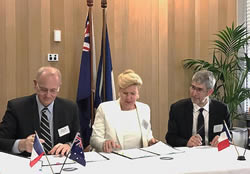 The Australian Nuclear Science and Technology Organisation (ANSTO) has launched a new area of space research, collaborating with two French agencies to study the impact of low energy particles on human cells in space.
The Australian Nuclear Science and Technology Organisation (ANSTO) has launched a new area of space research, collaborating with two French agencies to study the impact of low energy particles on human cells in space.
Strategic research agreements have been reached with the National Centre for Space Studies (CNES) and the National Institute of Health and Medical Research (INSERM). The memorandum of understanding signing is pictured.
Leader of Human Health Research at ANSTO, Marie-Claude Gregoire said that although spacecraft had adequate shielding to protect astronauts from high energy radiation, the effect of secondary, lower-energy particles was less understood.
“When high energy particles strike the spacecraft, they can produce fragments, secondary ions that are released as energy from the collision or are ripped from the shielding materials,” Professor Gregoire said.
“Theoretically the dose may not be that high, but there could be cumulative effects from heavy ions produced.”
She said it was very important to understand how cells responded when exposure was chronic as astronauts might be living in space for up to nine months, such as in the International Space Station.
“Our researchers will be looking at the biological pathways in human cells that could be disturbed by exposure over time and how they respond,” Professor Gregoire said.
“Our collaborator, INSERM will be providing cell lines from vulnerable areas of the body, such as the eyes, the skin and bone marrow for our experiments. CNES wanted the research undertaken but did not have access to facilities to create the low energy ion beam for the research,” she said.






